Coaxial cables, Twisted Pair STP and UTP cables, Twisted Pair Cable Categories (CAT)
Cables are commonly used to carry communication signals within Local Area Networks (LAN). There are three common types of cable media that can be used to connect devices to a network and they are coaxial cable, twisted-pair cable, and fiber-optic cable.
Coaxial Cables
Coaxial cable looks similar to the cable used to carry TV signal. A solid-core copper wire conductor runs down the middle of the cable. Around that solid-core copper wire is a layer of insulation, and covering that insulation is braided wire and metal foil shield, which shields against electromagnetic interference. A final layer of plastic insulation jacket covers the braided wire.
Following image shows the general structure of coaxial cable.
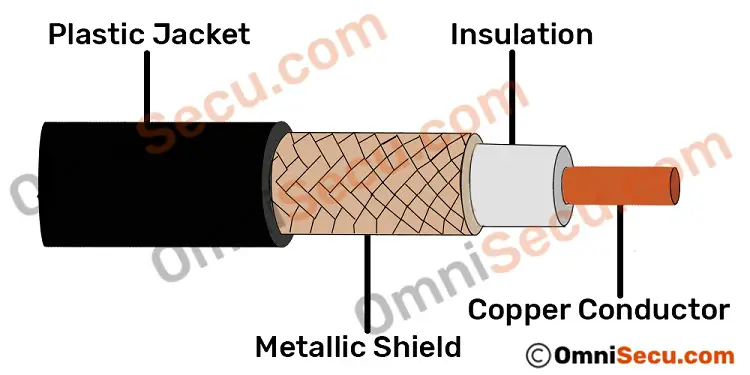
There are two types of coaxial cabling: ThinNet and ThickNet. ThinNet is a flexible coaxial cable about ¼ inch thick. ThinNet is used for short-distance. ThinNet connects directly to a workstation’s network adapter card using a British Naval Connector (BNC). The maximum length of thinnet is 185 to 200 meters. ThickNet coaxial cable is thicker cable than ThinNet. ThickNet cable is about ½ inch thick and can support data transfer over longer distances than ThinNet. ThickNet has a maximum supported cable length of 500 meters and usually is used as a backbone to connect several smaller ThinNet-based networks.
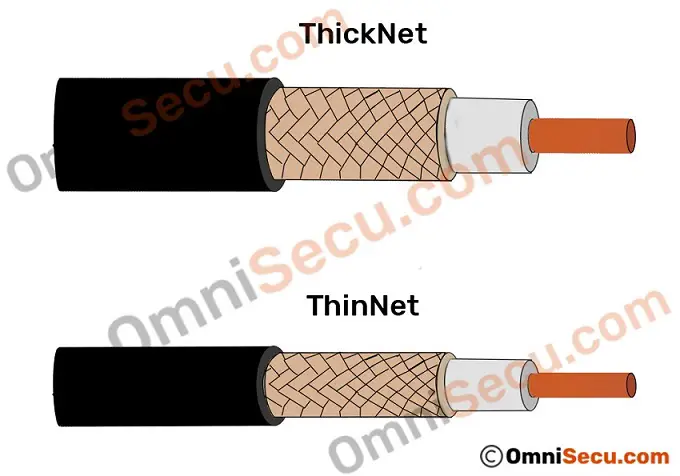
There are two Ethernet media standards defined for coaxial cable-based Ethernet. Those standards are 10Base2 and 10Base5.
10Base2 has a bandwidth speed of 10 Mbps, to a maximum distance of 200 meters. 10 denotes bandwidth speed and 2 denotes 200 meters. Base denotes baseband type of signal. Coaxial cable used for 10Base2 Ethernet media standard is ThinNet.
10Base5 has a bandwidth speed of 10 Mbps, to a maximum distance of 500 meters. 10 denotes bandwidth speed and 5 denotes 500 meters. Base denotes baseband type of signal. Coaxial cable used for 10Base5 Ethernet media standard is ThickNet.
The bandwidth available for both 10Base2 (Thinnet Ethernet) and 10Base5 (Thicknet Ethernet) were 10 Mbps (Megabits per second).
Type of Cable used to wire Local Area Networks (LAN) these days is Twisted Pair cable. It is extremely difficult to find a live business network using coaxial cable.
Twisted Pair Cables
Twisted-pair cable is the most common type of cabling you can see in today's Local Area Networks (LAN) networks. A pair of wires forms a circuit that can transmit data. The pairs are twisted to provide protection against crosstalk. Crosstalk is the undesired signal noise generated by the electromagnetic fields of the adjacent wires.
When a wire is carrying a current, the current creates a magnetic field around the wire. This field can interfere with signals on nearby wires. To eliminate this, pairs of wires carry signals in opposite directions, so that the two magnetic fields also occur in opposite directions and cancel each other out. This process is known as cancellation.
Color codes used for Twisted Pair wire’s plastic insulation are Orange, Orange-White, Blue, Blue-White, Green, Green-White, Brown and Brown-White.
Two types of twisted pair cables are Unshielded Twisted Pair (UTP) and Shielded Twisted Pair (STP).
Unshielded Twisted Pair (UTP) cables
Unshielded Twisted Pair (UTP) cable is the most common networking media. Unshielded Twisted Pair (UTP) consists of four pairs of thin, copper wires covered in color-coded plastic insulation that are twisted together. The wire pairs are then covered with a plastic outer jacket. UTP cables are of small diameter and it doesn’t need grounding. Since there is no shielding for UTP cabling, it relies only on "cancellation" to avoid noise.
Following image shows Unshielded Twisted Pair (UTP) cable.
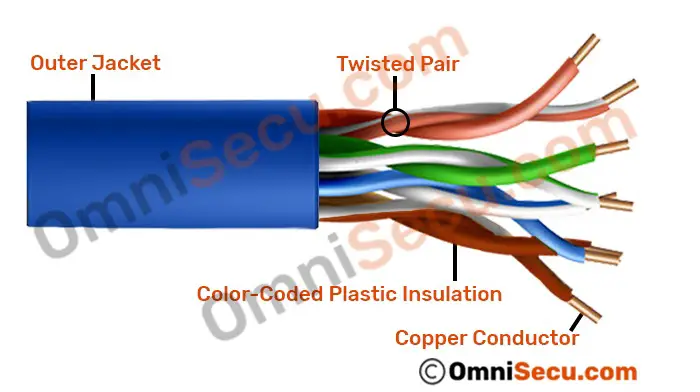
Shielded Twisted Pair (STP) cables
Shielded Twisted Pair (STP) cables additionally have an overall conducting metallic shields covering four twisted pair wires. There may be another conducting metallic shields covering individual twisted pairs also. These metallic shields blocks out electromagnetic interference to prevent unwanted noise from the communication circuit.
Drain wires are also used in Shielded Twisted Pair (STP) cables together with metallic shields for grounding purpose. The drain wire provides a low-resistance connection to shield for better grounding. The main purpose of drain wire is to carry away unwanted interference noise to ground.
Click following link to learn about different types of STP cables - F/UTP, S/UTP, SF/UTP, S/FTP, F/FTP, U/FTP cables.
Following images show two different types of Shielded Twisted Pair cables (STP).
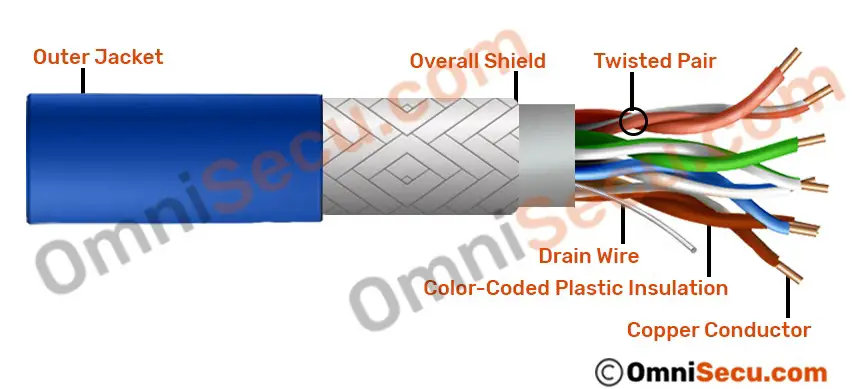
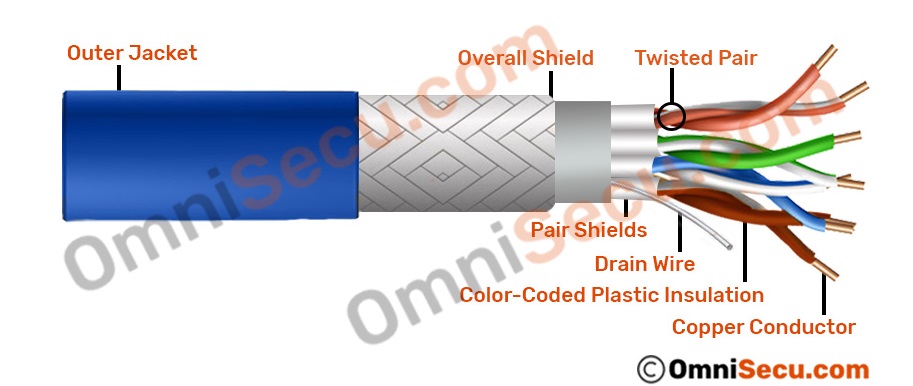
The connector used on a UTP cable is called as RJ-45 (Registered Jack 45) connector. Below picture shows an RJ45 jack, attached to UTP cable. Eight color-coded wires inside Twisted-Pair cable is attached to eight pins in a RJ45 jack as shown below. Each wire in the Twisted Pair cable is crimped into 8 pins in the RJ45 jack.
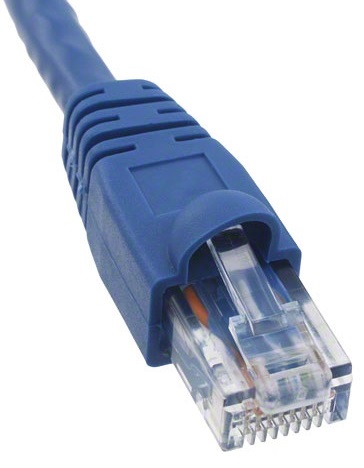
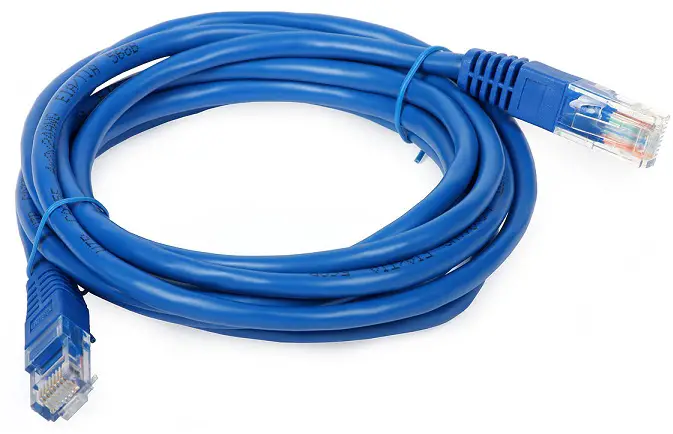
One end of the Twisted Pair cable with RJ45 jacks attached is plugged in to computer's Ethernet NIC card port and other end is plugged to the wall mount plate with female RJ45 port (receptacle), as shown below.
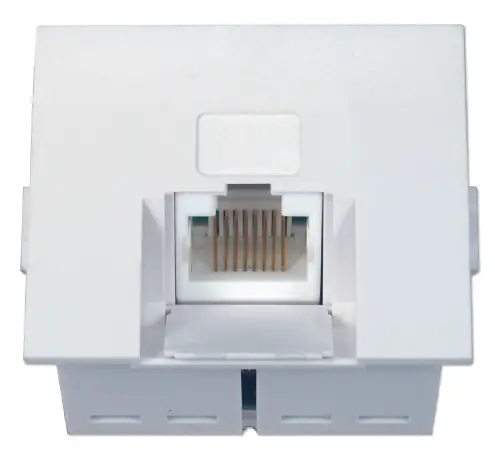
From the wall mount RJ45 female receptacle, Twisted Pair cable is wired to the Local Area Network (LAN) switches. Please refer below image.
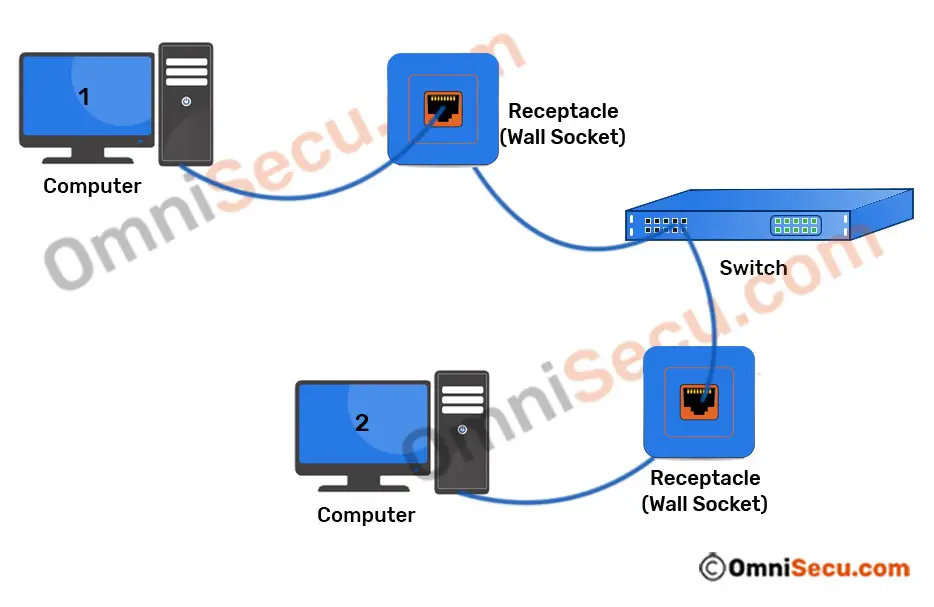
Twisted pair cables Categories
Twisted pair cables have different categories. Each category of twisted pair cabling was designed for a specific type of communication or transfer rate. The most popular categories in use today is Cat 6, Cat 6a and Cat 7. Cat 6, Cat 6a and Cat 7 twisted pair cables can reach transfer rates of over 1000 Mbps (1 Gbps).
Generally twisted pair cables support a maximum distance of 100 Meters (from NIC Card to Switch Port), without signal distortion.
The following table shows different twisted pair categories and corresponding transfer rate.
UTP Category |
Purpose |
Frequency |
Transfer Rate |
|---|---|---|---|
Category 1 |
Voice Only |
|
|
Category 2 |
Data |
4 MHz |
4 Mbps |
Category 3 |
Data |
16 MHz |
10 Mbps |
Category 4 |
Data |
20 Mbps |
16 Mbps |
Category 5 |
Data |
100 MHz |
100 Mbps |
Category 5e |
Data |
100 MHz |
1 Gbps |
Category 6 |
Data |
250 MHz |
Upto 10 Gbps |
Category 6a |
Data |
500 MHz |
Upto 10 Gbps |
Category 7 |
Data |
600 MHz |
Upto 10 Gbps |
Category 7a |
Data |
1 GHz (1000 MHz) |
40 to 100 Gbps |
Category 8 |
Data |
2 GHz (2000 MHz) |
25 to 40 Gbps |
Optical Fiber Cabling
Optical Fiber cables use optical fibers that carry digital data signals in the form of modulated pulses of light. An optical fiber consists of an extremely thin cylinder of glass, called the core, surrounded by a concentric layer of glass, known as the cladding. There are two fibers per cable—one to transmit and one to receive. The core also can be an optical-quality clear plastic, and the cladding can be made up of gel that reflects signals back into the fiber to reduce signal loss.
There are two types of fiber optic cable: Single Mode Fiber (SMF) and Multi Mode Fiber (MMF).
1. Single-mode Fiber (SMF) uses a single ray of light to carry transmission over long distances. Please click next link to learn more about single mode fiber (SMF).
2. Multi-mode Fiber (MMF) uses multiple rays of light simultaneously with each ray of light running at a different reflection angle to carry the transmission over short distances. Multi-mode fiber cables can transmit data at 100 Mbps (megabits per second) for distances up to 2 kilometers (100Base-FX), 1 Gbps up to 1000 meters (1 kilometer), and 10 Gbps up to 550 meters. Please click next link to learn more about multimode fiber (MMF).